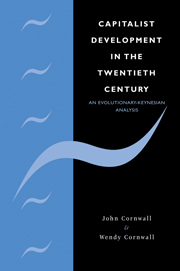Book contents
- Frontmatter
- Contents
- List of figures
- List of tables
- Foreword by David Colander
- Preface
- Part I Framework
- 1 Economic development and economic performance
- 2 The stylized facts
- 3 The neoclassical analysis of unemployment
- 4 An extended Keynesian model
- 5 Institutions and power
- 6 Evolutionary and hysteretic processes
- 7 Theories of capitalist development
- Part II Explaining the development record
- Part III Political control of the economy
- Bibliography
- Index
2 - The stylized facts
Published online by Cambridge University Press: 22 September 2009
- Frontmatter
- Contents
- List of figures
- List of tables
- Foreword by David Colander
- Preface
- Part I Framework
- 1 Economic development and economic performance
- 2 The stylized facts
- 3 The neoclassical analysis of unemployment
- 4 An extended Keynesian model
- 5 Institutions and power
- 6 Evolutionary and hysteretic processes
- 7 Theories of capitalist development
- Part II Explaining the development record
- Part III Political control of the economy
- Bibliography
- Index
Summary
The stylized facts
Kaldor (1963) maintained that, in order to choose between competing theoretical approaches, it is first necessary to agree on the broad historical tendencies of macroeconomic development we wish to explain. These he termed the ‘stylized facts’. We have chosen the alternating episodes of good and poor macroeconomic performance as the stylized fact of greatest interest, but include differences in the performance of economies that have shown this common historical pattern and the unbalanced nature of the growth process as additional aspects of development to be recognized and explained. In this chapter we briefly describe these tendencies as a background for discussion and evaluation of the mainstream analysis of the dynamics of output and unemployment, topics continued in chapter 3.
Unemployment and growth patterns
Table 2.1 records rates of unemployment and rates of growth of per capita incomes and GDP for 16 developed capitalist economies for which comparable data are available. Beginning with the ‘boom’ years of the 1920s, most of the economies experienced periods of low unemployment and rapid per capita income growth alternating with periods of high unemployment and slow growth. Notable exceptions were Germany and Japan, where rearmament programmes led to booms in the 1930s. Most other economies endured a marked deterioration of macro performance in the 1930s compared with the 1920s. The strong recovery during the golden age episode of 1955–73 stands out, as does the widespread poor performance of the post-1973 period.
- Type
- Chapter
- Information
- Capitalist Development in the Twentieth CenturyAn Evolutionary-Keynesian Analysis, pp. 20 - 36Publisher: Cambridge University PressPrint publication year: 2001

